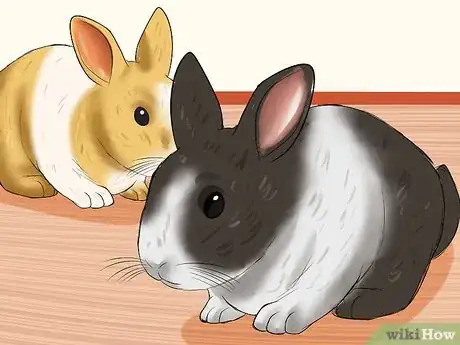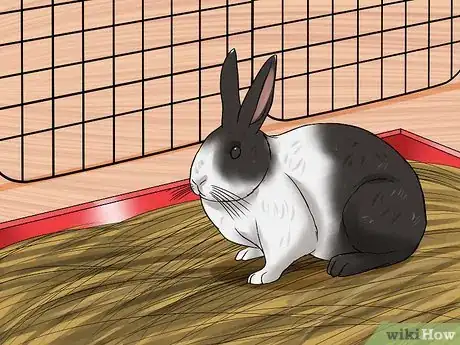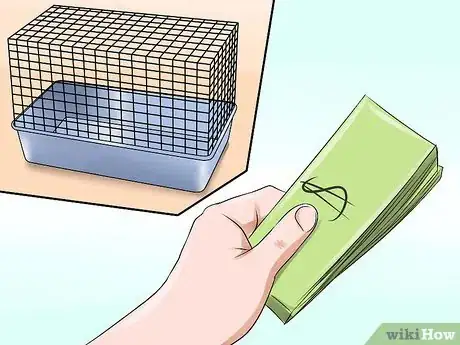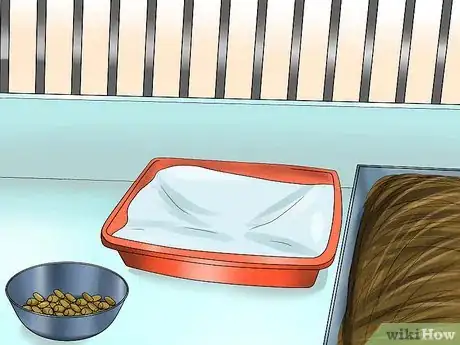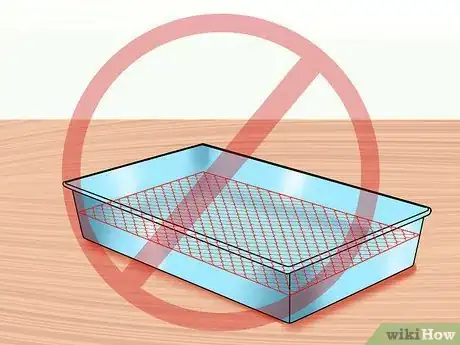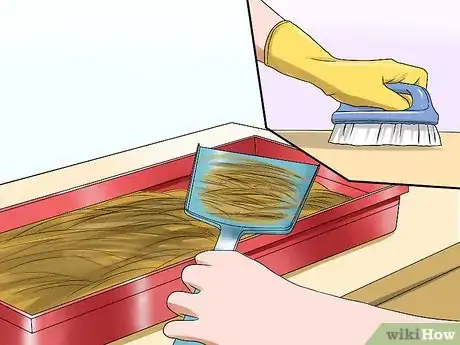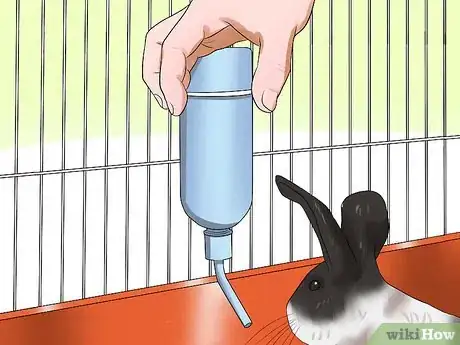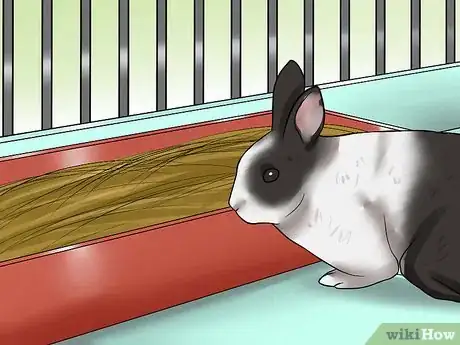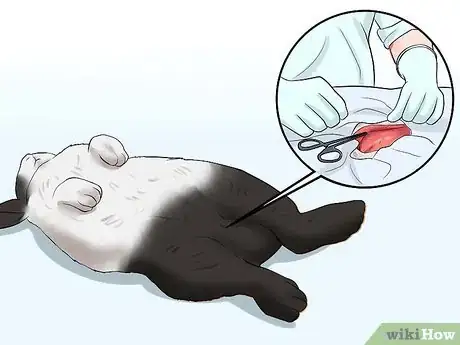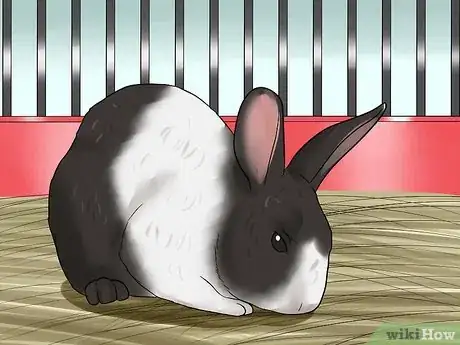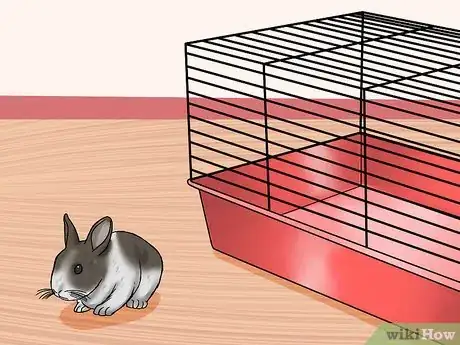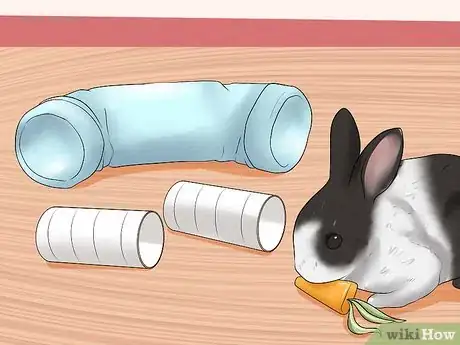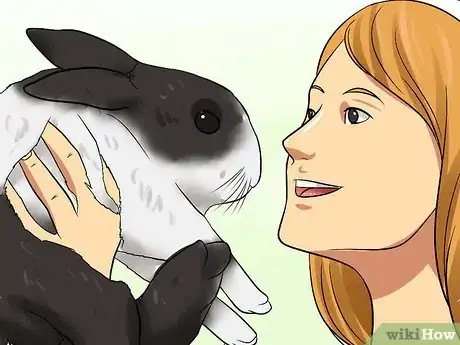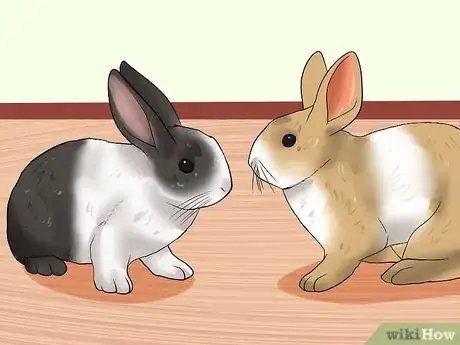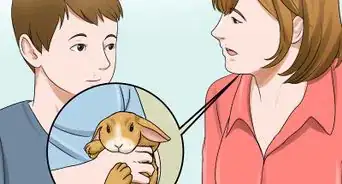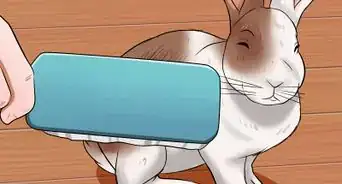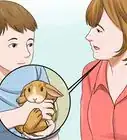This article was co-authored by Pippa Elliott, MRCVS. Dr. Elliott, BVMS, MRCVS is a veterinarian with over 30 years of experience in veterinary surgery and companion animal practice. She graduated from the University of Glasgow in 1987 with a degree in veterinary medicine and surgery. She has worked at the same animal clinic in her hometown for over 20 years.
There are 7 references cited in this article, which can be found at the bottom of the page.
wikiHow marks an article as reader-approved once it receives enough positive feedback. In this case, 92% of readers who voted found the article helpful, earning it our reader-approved status.
This article has been viewed 48,167 times.
The Dutch rabbit is familiar to most people, even if they aren't aware of the name of the breed. They have compact, rounded bodies and distinctive markings, with a white background, a helmet of color on the ears and face, and the same color on the rear end. The Dutch rabbit was one of the earliest "fancy" rabbits and has been widely kept as a pet for many decades. It is a popular children's rabbit, mainly because they are even-tempered and less prone to aggression than other rabbit breeds.[1] Their character is a good mid-path between being sociable but without being overly needy, and gentle but resilient enough to withstand some of the energy of family life.[2]
Steps
Deciding to Get a Dutch Rabbit
-
1Assess whether to bring a rabbit into your family. The average lifespan is around 5 - 8 years, although neutering your pet Dutch rabbit, especially the females, could well extend their life. Be sure that you can commit to providing a healthy and happy home for the rabbit for as long as it lives.[3]
-
2Choose a Dutch rabbit if you want a house rabbit. If you are looking for a rabbit to train as a house rabbit, then the Dutch rabbit is a good choice. They are intelligent and respond well to being trained, and they pick up litter box training quickly. Their even temperament makes them reliable with children, however, it should be noted that rabbits (regardless of breed) are all prey animals. This means they dislike being picked up and are easily startled.
- Fear can easily send a rabbit into shock, and likewise their delicate bones are easily fractured by rough handling. All of this means that your pet rabbit should be treated with respect, and children (especially under the age of 10) should be supervised with a rabbit at all times.[4]
Advertisement -
3Be sure that you can provide a calm and healthy environment for the rabbit. Only consider getting a rabbit if you can provide a calm, predator free environment for it. Think twice if you already own dogs or cats, as the rabbit may then live in a perpetual state of fear, being expected to live in close confines with its natural enemy.
- Also, be prepared to spend time every day cleaning the rabbit's living space and spending quality time interacting and playing, so that the rabbit won't become bored or lonely. If you can't commit to this, then get a cuddly toy rather than a pet rabbit.
-
4Prepare for the financial cost of a rabbit. You should make financial provision to provide veterinary care for your Dutch rabbit should they become ill. Be aware that rabbit medicine and surgery is much more advanced than previously. However, not all veterinarians are knowledgeable about the species or comfortable treating them. For the sake of your new furry friend it is best to ask around and find an "exotics" vet who has further qualifications in treating rabbits, or at very least is interested in them and undertakes CPD (continuing professional development) in the species.
- Also, proper veterinary care for rabbits costs the same as for a cat or dog, so don't expect it to cost less just because the initial purchase price of the pet was lower.
- Prepare for veterinary expenses by taking out pet insurance, with some insurance companies now offering rabbit policies.
- Make a list of potential costs and add them up before buying the rabbit. Any prospective rabbit keeper must be prepared to provide for all their pet's needs in terms of housing, good diet, health care, mental stimulation and exercise.
Housing Your Dutch Rabbit
-
1Decide whether to keep the rabbit inside or outside. Your first decision is to decide where to house your rabbit. The ASPCA encourage indoor rabbits, as they are less likely to be 'forgotten' about than a rabbit that is out of sight in a yard.
- If you do house your Dutch rabbit outdoors, you need to make sure they have shelter from the rain, sun, and wind, and that the enclosure is predator proof.
-
2Buy a cage. A wide variety of indoor cages and hutches are available. They can range from a whole room that is rabbit-proofed, to a puppy crate, to rabbit condos.[5] Whatever your choice, the important thing is the rabbit has plenty of space to move around, plus specific areas for a litter tray, food and water, and a hide.
- If you have more than one rabbit then each animal should have the option of a separate hide so they can withdraw if they feel overwhelmed for any reason.
- The minimum length of an indoor hutch and run should be 4 foot (1.2 m), but preferably 5 foot, and these are usually half as wide as they are long. They should be high enough to let the rabbit stand up on its hind legs without its ears touching the top. However, even with a run of this size, the rabbit should be allowed free roaming time everyday, so it gets plenty of exercise and time to forage, explore, and prevent boredom.[6]
-
3Provide a litter box, bedding area, and eating area in the cage. Within the hutch you should provide a litter tray. Rabbits are clean animals and Dutch rabbits especially will rapidly learn to use a toilet area. Paper-pulp type litter is ideal, as it is less harmful to the rabbit if eaten than clay-based cat litters (which you should avoid).
- Each rabbit should have its own shelter, where it can retreat if it feels stressed. If a rabbit is stressed its natural instinct is to hide, and providing hiding places goes a long way to reducing additional stress.
-
4Pay attention to the flooring in the cage. Wire floors are NOT acceptable, as they damage the rabbit's feet. If the cage has a wire floor either remove it or cover with with plywood. Dutch rabbits are liable to get pododermatitis, which is the equivalent of pressure sores on the back of their hocks (equivalent to the human ankle). This is painful and debilitating and the most common cause is rough or mesh flooring, or sitting in soiled bedding that is not changed often enough.
- Make sure the floor is covered with a minimum of 2–3 inches (5.1–7.6 cm) depth of bedding. There are numerous substances that can be used for bedding, including straw (warm and soft), paper pulp (recycled material, safe and high absorbent), and shredded cardboard.[7] Traditionally sawdust was used for rabbit bedding but this can be dusty and also contains oils that are irritating to the rabbit's lungs and therefore best avoided.[8]
-
5Keep the cage clean. Spot clean the litter tray daily and removed urine soil and pellets. Clean the tray fully with disinfectant once a week, or sooner if the tray starts to smell.
- Be aware that rabbits pass two different types of pellets: a small dry pellet that is entirely waste material and a larger sticky cecotrophy. The cecotrophy represents food that has passed through the gut but still contains nutrition and the rabbit needs to re-eat it. Never remove cecotropes from the litter tray or you could be depriving your rabbit of valuable nutrition.
Feeding Your Rabbit
-
1Give your rabbit access to water at all times. It is important that it can drink whenever it wants to. Be sure the water is clean and that its water dish or water bottle is also clean.
-
2Give your rabbit access to grass or hay at all times. In the wild rabbits forage and eat vegetation, shoots, leaves, herbage, and grass. This is a high fiber, low calorie diet. The rabbit spends many hours continually chewing in order to get the nutrition they need. In the domestic setting grazing on a lawn mimics this diet, but if this is not possible then hay is the next best option.
- The rabbit should have good quality green hay available 24/7 as the main portion of their diet. The chewing required keeps their teeth in trim and it provides vital fiber that keeps their digestion healthy.
-
3Give the rabbit some fresh pellets every day. It is acceptable to give a small portion of rabbit kibble each day, around the amount one rabbit can eat in 20 minutes. Do not give so many pellets that the rabbit can graze on it all day. Rabbits that are fed a high proportion of their diet as kibble are prone to weight gain, and this can cause them health problems such as sore hocks, skin infections, fly strike, and arthritis.
- Choose an extruded diet, which means each biscuit is identical. Avoid muesli type dry foods as the rabbit will selectively eat the tasty parts, which are also the unhealthy part (low fiber, low calcium, high calorie) and leave the less tasty but nutrition rich components.
-
4Offer fresh vegetables or fruit every day. Rotate what you give so the rabbit never gets the same food two days running.[9] Be aware that fruit is high in sugar and should be fed in small quantities to avoid your Dutch rabbit becoming overweight.
- Fresh foods to avoid include tomato leaves, potato tops, bracken, laburnum, yew, oak leaves, poppies, and rhubarb leaves
Taking Care of Your Rabbit's Health
-
1Get your rabbit desexed. Female rabbits are does, and male rabbits are bucks. Does can get pregnant from around 4 - 5 months of age, and males can breed at roughly the same age. Thus, there is a high risk of pregnancy if both sexes are housed together. Desexing is strongly advised, and helps to make males less territorial and therefore better pets. There is a strong health benefit to neutering the females as does are at a high risk of uterine adenocarcinoma (womb cancer) and removing the womb during surgery removes this risk.
- Desexing is commonly performed from around 4 months of age.
-
2Get routine veterinary exams. Get your Dutch rabbit checked by a vet soon after purchase. A yearly check up is also advised. In the UK it is usual to vaccinate annually against myxomatosis and viral hemorrhagic disease. Your veterinarian should tell you what vaccinations are common, and important, in your area.
-
3Watch for signs of ill health. Be alert for signs that your Dutch rabbit might be unwell. These include not eating (even if just for 12 - 24 hours you should seek urgent veterinary attention), lack of pellet production, a wet chin, limping, sneezing or wheezing, a wet nose, discharge from the eyes, excessive scratching, and diarrhea.[10]
- Seek urgent veterinary attention if you see any of these symptoms, as rabbit's deteriorate rapidly when they are ill.
Enriching Your Rabbit's Life
-
1Don't keep the rabbit in its cage all the time. Be sure to allow your rabbit a chance to roam free in the house each day. If you don't want to let the rabbit roam the house, at least take it out of its cage and let it hop around one area or in a pen.
- Ensure the house is "rabbit proof." This means putting all electrical cables out of reach, as rabbits will gnaw through them and electrocute themselves.
-
2Groom your rabbit. Brush the rabbit daily. This helps you to bond with each other, it builds trust, and it gets the rabbit used to being touched.
-
3Consider enriching their environment by providing toys. These can be as simple as cardboard tubes with a food treat in the center, held in place by plugs of hay. The rabbit has to remove the plugs of hay to get the treat. This is fun for the rabbit and it stimulates its mind.
-
4Take care when lifting your rabbit. Never lift a rabbit by the ears. A 'rugby ball' hold is ideal, with the weight of the rabbit's body supported along your forearm with its rear end snuggled into your elbow and the opposite hand steadying its head.
- If you are not confident picking a rabbit up, then consider wrapping it in a towel so it is supported and its claws don't scratch you.
-
5Consider getting a second rabbit. If you are unable to give your Dutch rabbit a lot of attention, consider getting two rabbits so they keep each other company. If you keep a male and female, then it is essential to neuter them. Alternatively, get two rabbits of the same gender from the same litter and then they should grow up together and tolerate each other well.
Expert Q&A
-
QuestionWhat is the life expectancy of a Dutch rabbit?
 Pippa Elliott, MRCVSDr. Elliott, BVMS, MRCVS is a veterinarian with over 30 years of experience in veterinary surgery and companion animal practice. She graduated from the University of Glasgow in 1987 with a degree in veterinary medicine and surgery. She has worked at the same animal clinic in her hometown for over 20 years.
Pippa Elliott, MRCVSDr. Elliott, BVMS, MRCVS is a veterinarian with over 30 years of experience in veterinary surgery and companion animal practice. She graduated from the University of Glasgow in 1987 with a degree in veterinary medicine and surgery. She has worked at the same animal clinic in her hometown for over 20 years.
Veterinarian A well-cared for Dutch rabbit can live up to around 8 - 10 years. A big cause of early death in female rabbits is uterine cancer, so get a female spayed for the best chance of long life.
A well-cared for Dutch rabbit can live up to around 8 - 10 years. A big cause of early death in female rabbits is uterine cancer, so get a female spayed for the best chance of long life. -
QuestionWhat do Dutch rabbits like to eat?
 Pippa Elliott, MRCVSDr. Elliott, BVMS, MRCVS is a veterinarian with over 30 years of experience in veterinary surgery and companion animal practice. She graduated from the University of Glasgow in 1987 with a degree in veterinary medicine and surgery. She has worked at the same animal clinic in her hometown for over 20 years.
Pippa Elliott, MRCVSDr. Elliott, BVMS, MRCVS is a veterinarian with over 30 years of experience in veterinary surgery and companion animal practice. She graduated from the University of Glasgow in 1987 with a degree in veterinary medicine and surgery. She has worked at the same animal clinic in her hometown for over 20 years.
Veterinarian As with any rabbit, their ideal diet is grass, tender herbage, and plant shoots. To mimic this for the indoor rabbit, feed a diet of sweet green hay, supplemented with a variety of fresh fruit and veg, and a small spoonful of rabbit pelleted food.
As with any rabbit, their ideal diet is grass, tender herbage, and plant shoots. To mimic this for the indoor rabbit, feed a diet of sweet green hay, supplemented with a variety of fresh fruit and veg, and a small spoonful of rabbit pelleted food. -
QuestionCan a rabbit be trained?
 Pippa Elliott, MRCVSDr. Elliott, BVMS, MRCVS is a veterinarian with over 30 years of experience in veterinary surgery and companion animal practice. She graduated from the University of Glasgow in 1987 with a degree in veterinary medicine and surgery. She has worked at the same animal clinic in her hometown for over 20 years.
Pippa Elliott, MRCVSDr. Elliott, BVMS, MRCVS is a veterinarian with over 30 years of experience in veterinary surgery and companion animal practice. She graduated from the University of Glasgow in 1987 with a degree in veterinary medicine and surgery. She has worked at the same animal clinic in her hometown for over 20 years.
Veterinarian Rabbits can be trained to do simple tasks such as jump a hurdle or come for food. Clicker training is ideal, as this method helps them understand which action it is that is being rewarded.
Rabbits can be trained to do simple tasks such as jump a hurdle or come for food. Clicker training is ideal, as this method helps them understand which action it is that is being rewarded.
References
- ↑ http://www.verlannahill.com/AboutDutch.htm
- ↑ http://www.rabbitmatters.com/dutch-rabbit.html
- ↑ http://www.verlannahill.com/AboutDutch.htm
- ↑ http://www.rabbitmatters.com/dutch-rabbit.html
- ↑ http://myhouserabbit.com/rabbit-care/housing-your-pet-rabbit-indoors/
- ↑ http://www.therabbithouse.com/indoor/
- ↑ http://www.bunnyhugga.com/a-to-z/housing/rabbit-bedding.html
- ↑ http://www.bunnyhugga.com/a-to-z/housing/rabbit-bedding.html
- ↑ http://www.saveafluff.co.uk/rabbit-info/safe-foods-for-rabbits
About This Article
To care for Dutch your rabbit, make sure it has 24-7 access to quality green hay, which gives it vital fiber to keep its digestion healthy. In addition to hay, give your rabbit a small amount of fresh pellets and fresh fruits and veggies each day for extra nutrients. When your rabbit is around 4 months old, you should have it desexed, an operation that makes males less territorial and reduces the risk of womb cancer in females. You should also take your rabbit to the vet for routine check-ups at least once per year, and make sure it gets to vaccines that your vet recommends. For more tips from our Veterinary co-author, like how to groom your rabbit, keep reading!

